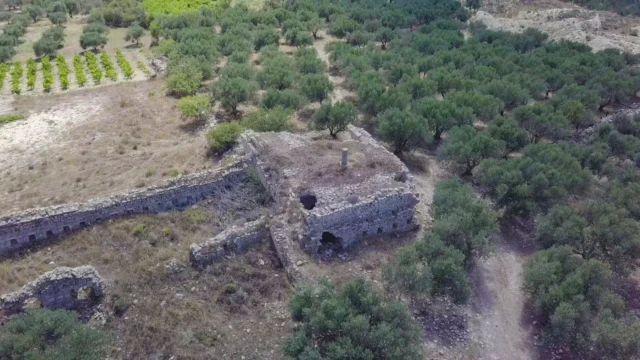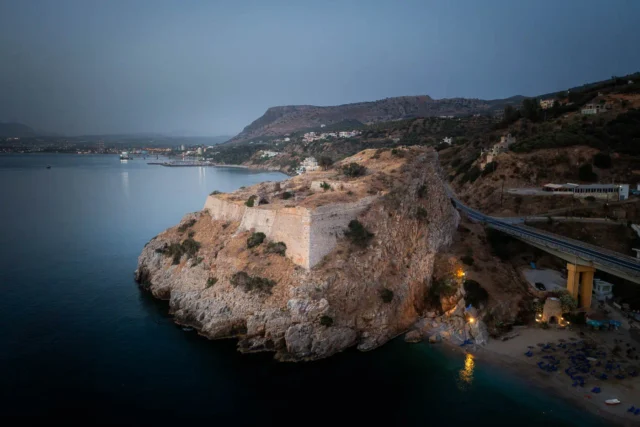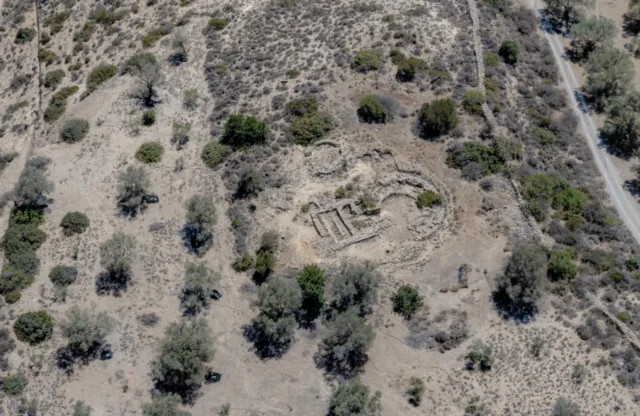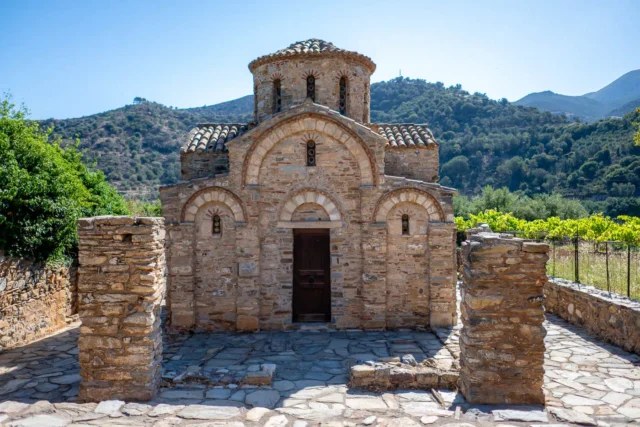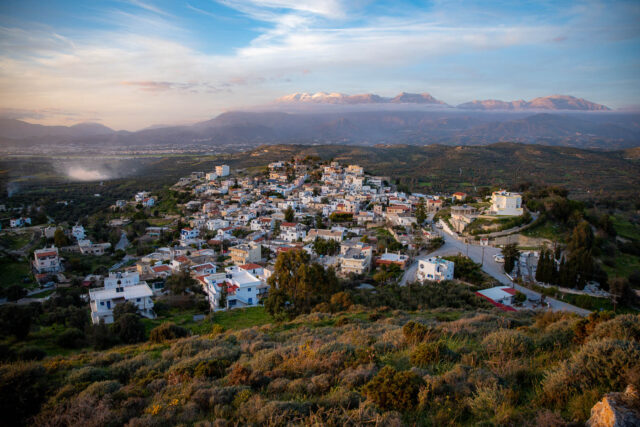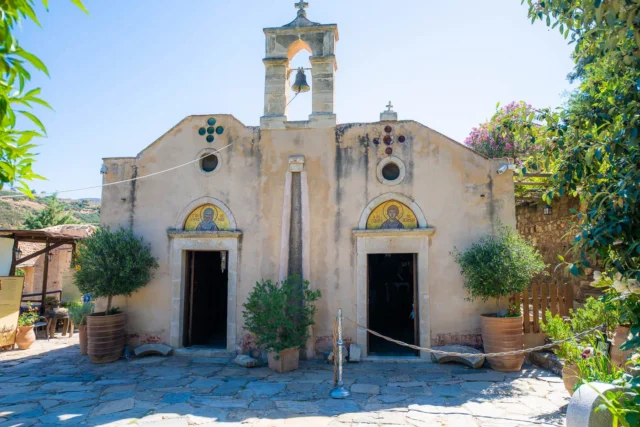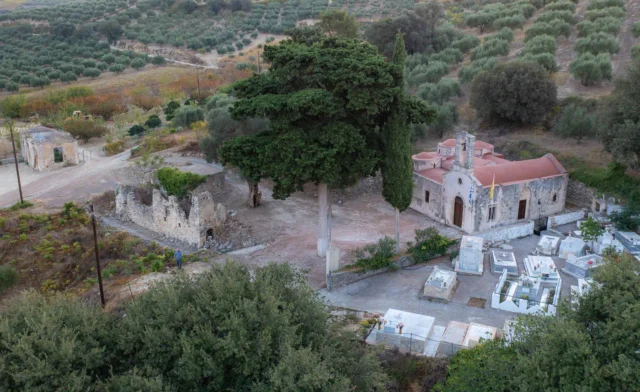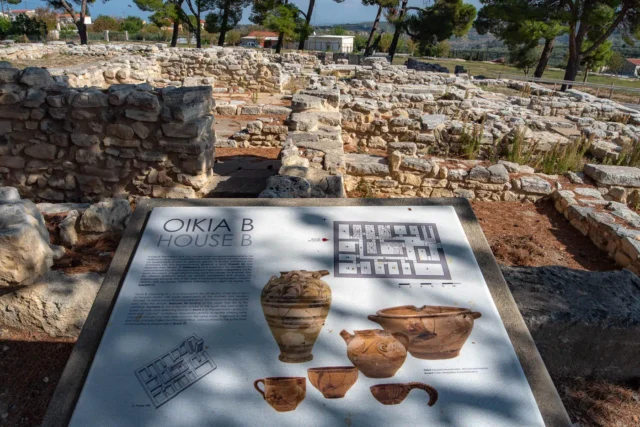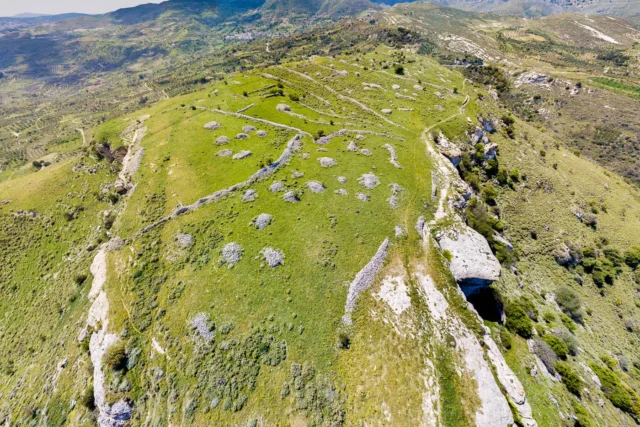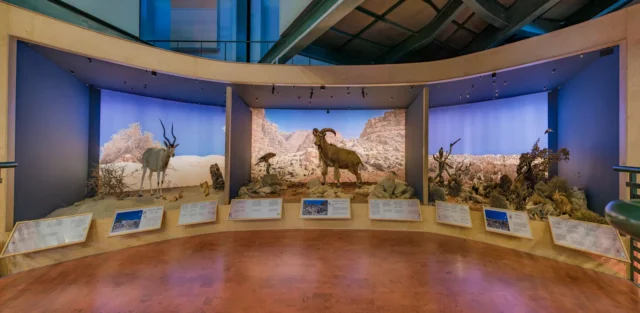415
listings found
Categories
Active filters:
Moni Kallergi
Moni Kallergi, dedicated to Saint John the Baptist, is a historical monastery southeast of Smari, Crete, near Kastelli. Built during the Venetian era, it rests on Minoan-era ruins, evidenced by tombs and artifacts. Records link it to the Kallergis family. Though damaged during Ottoman rule and a 1931 fire, it was restored in the 20th and 21st centuries. Now an active monastery under the Metropolis of Arkalochori, it includes a restored central building, a two-aisled church dedicated to Saint George and Saint Spyridon, and a chapel for the New Martyrs of Crete. The site showcases a blend of Minoan and Venetian history, with ongoing services and visitor access.
Palaiokastro Fortress: Guardian of Heraklion Bay
The Palaiokastro Fortress, built by Venetians (1573-1595) on a cliff overlooking Palaiokastro Beach near Heraklion, Crete, defended Heraklion Bay. Its three levels housed powder magazines, a cistern, barracks, and a chapel. The winged lion of St. Mark on its walls signifies Venetian heritage. Captured by Ottomans in the Cretan War (1645-1669), the fortress was documented in the 1900s by G. Gerola. Now partly ruined, it's undergoing restoration.
Minoan Archaeological Site at Odigitria Monastery
The Odigitria Cemetery in Crete's Asterousia mountains is an archaeological site dating back to the Early Minoan (EM) period.
It features two tholos tombs (A and B), a Rectangular Building, courtyards, an ossuary, and a possible altar, all enclosed within a peribolos wall. The site's three construction phases span from the Final Neolithic to the Middle Minoan (MM) era. Tholos A, the smaller of the two tombs, contained undisturbed EM I pottery, while Tholos B boasts a unique complete outer wall. The Rectangular Building may have served as an independent burial building or ritual space. The courtyards, particularly the Eastern and Outer Courtyards, likely hosted rituals associated with the deceased. The ossuary reveals the practice of secondary burial, where bodies were initially interred in the tholos tombs or pithoi and later transferred to the ossuary. The Odigitria Cemetery provides significant insights into Early and Middle Minoan burial practices, social structures, and material culture.
Apesokari Tholos tombs
The Apesokari Tholos Tombs in Crete are significant Early Minoan burial sites. Tholos Tomb A features a unique circular burial chamber and annex, used for both primary and secondary burials. Tholos Tomb B includes multiple rooms with evidence of communal drinking and larnax burials. Both tombs offer valuable insights into Early Minoan funerary practices and social organization.
Knossos archaeological site
The Palace of Knossos, located on the Kephala hill south of Heraklion, Crete, is an important site of the ancient Minoan civilization. Occupied since around 7000 BCE during the Aceramic Neolithic period. The First Palace, built during the Middle Minoan IB-IIA period, represents a significant shift in Minoan society from a clan-based structure to a hierarchical one. This monumental building, covering nearly 10,000 square meters on the ground floor alone, served as a hub for administrative, storage, and cult activities. The First Palace also introduced innovative features like storage magazines, showcasing the society's wealth and resources. The New Palace emerged after a massive earthquake that occurred at the end of the Middle Minoan IIIA period, the palace underwent major reconstruction in the Middle Minoan IIIB period. Around 1450 BCE, widespread destruction occurred across Crete, affecting palaces and settlements. While Knossos suffered damage, it wasn't destroyed like other palaces. This period saw the introduction of Linear B, an early form of Greek script used by the Mycenaeans, suggesting their presence at Knossos. The final destruction of the palace, possibly in Late Minoan IIIA2 (1325-1300 BCE), left it deserted, but the town continued to exist. Knossos continued to be inhabited during the Classical, Hellenistic and Roman periods. Two basilicas from the First Byzantine period indicate that the city was still active during this time. Knossos appears to have followed the fate of other urban centers in Crete and declined early.
Malia Minoan Palace
The Minoan archaeological site at Malia, located on the northern coast of Crete, is a significant site for understanding the Bronze Age civilization. The Palace of Malia is the third largest Minoan palace discovered. The palace and surrounding town and cemeteries offer a glimpse into the complex social, political, economic, and religious structures of Minoan society. The area was inhabited as early as the Early Neolithic period. The first monumental architecture at Malia, often referred to as the Old Palace, dates to the Early Minoan IIB period. This structure, or group of structures, was built around a large open space, sharing the same alignment as the later palace. The second palace, whose ruins are visible today, was built in the Late Minoan IA period, around 1650 BCE. It was constructed on the ruins of the Old Palace, inheriting its basic layout and orientation. The palace's central court, a defining feature of Minoan architecture, is oriented north-south. The New Palace at Malia met its demise around 1450 BCE, coinciding with the destruction of other Minoan sites across Crete. The cause of this widespread destruction remains a topic of scholarly debate.
Panagia ton Angelon in Fradio
Panagia ton Angelon, a 15th-century Catholic church in Fradio, Crete. Gothic influences and monastery ruins mark this historic site.
Museum of Domenikos Theotokopoulos (El Greco)
The Museum of Domenikos Theotokopoulos (El Greco), situated in the village of Fodele, Crete, serves as a tribute to the renowned artist’s formative years and artistic legacy. Established in 1998, […]
Church of Panagia (The Virgin Mary)
The Church of Panagia (The Virgin Mary) is located in the village of Fodele, Crete, on the site of a ruined 7th-century three-aisled basilica. The current church dates to the […]
Kamilari, Phaistos
Kamilari is a village in the Asterousia mountains of Crete. Its history dates back to the Minoan era. The village's name, first recorded in 1370, is likely derived from the Byzantine family name "Kamelaris" or the term "Hamilon Oros," meaning "Low Mountain."
Kamilari is archaeologically significant, with nearby sites like the Minoan palace of Phaistos and the Kamilari Tholos Tomb. The discovery of a bothros containing terracotta figures from the Geometric period confirms the area's long history of human presence.
The village's Cultural Association works to preserve local traditions and customs. Kamilari offers a unique experience for visitors to Crete.
Agios Panteleimon monastery in Fodele
Located in Fodele, 25 km from Heraklion, this Greek Orthodox monastery dates to the early Ottoman period, possibly after 1539. Its fortress-like architecture combines Byzantine and Venetian styles. It served as a rebel shelter during Cretan uprisings against the Ottoman Empire, notably the 1866-1869 revolt under Abbot Neophytos Pediotis. Largely demolished in 1972, its legacy was preserved by Archimandrite Meletios Apostolakis, with restoration starting in 2004. The two-aisled basilica houses 14th- and 17th-century icons.
Panagia Kera Eleoussa in Kitharida
Panagia Kera Eleoussa in Kitharida, near Heraklion, Crete, is a striking example of Byzantine ecclesiastical architecture. Serving as the katholikon of the Panagia Eleoussa monastery from the 11th century (with 12th/13th-century narthex and 15th-century reconstruction), it operated through Venetian and Ottoman periods. The church comprises three domed aisles dedicated to Agios Charalampos, the Dormition of the Theotokos, and Agios Fanourios. The unusual apses face north, and its exterior displays circular plaques with paintings, including a notable Spanish plaque with "Ave Maria gratia plena." Today, it remains alongside ruined cells and a roofless school (1841-1866)
Ancient Tylissos
Tylissos, an ancient Minoan town located on the slopes of Mount Psiloritis in Crete, thrived between 1650 and 1200 BC. The town's strategic location on a major Minoan road contributed to its prosperity. Excavations have revealed three grand palaces (Megaron A, B, and C), showcasing remarkable Minoan architecture. Megaron A, the best-preserved, features a central courtyard, apartments, and storage rooms.
Significant finds include bronze cauldrons, a bronze figurine, Linear A tablets, and miniature frescoes comparable to those found in Knossos. These discoveries suggest Tylissos was a center for bronze working and played an important role in the Minoan civilization. Numerous tombs dating back to 1400-1200 BC have also been unearthed, containing painted sarcophagi, vases, jewelry, and seals, offering further insights into Minoan burial practices and culture.
Ancient Rizinia
Rhizenia, also known as Prinias, was a city in central Crete during the Late Minoan IIIC period (around 1200 BC). Located on the Patela plateau, it held a strategic position overlooking key communication routes. Rhizenia likely played a crucial role in the region's political and economic landscape. The necropolis of Siderospilia has revealed much about burial practices and social structures of the time. The city's political system was unique, possibly incorporating both aristocratic and democratic elements. Archaeological investigations have revealed insights into urban layout, religious practices, and daily life. Imported artifacts from Cyprus and Egypt underscore Rhizenia's integration into a wider network of exchange during the Early Iron Age.
Minoan Shipyard at Agii Theodori
The Minoan civilization on Bronze Age Crete heavily relied on maritime prowess, establishing extensive Mediterranean trade networks with Egypt, Cyprus, and the Levant through advanced shipbuilding and strategic harbor towns. The archaeological site at Agii Theodori, on Vathianos Kambos beach near Heraklion, exemplifies this. Dating to the Late Minoan I period (c. 1600-1450 BC), it features a significant, carved dry dock (approx. 48m x 11m) and timber storage areas, indicating a dedicated shipyard. Its peninsula location offered protection and sea access. This site, near the Palace of Knossos and the port of Amnisos, underscores Minoan maritime dominance, shipbuilding ingenuity, and the vital role of coastal settlements in their economic and cultural expansion.
Natural History Museum of Crete, University of Crete
Operating under the University of Crete in Heraklion, the Natural History Museum of Crete (NHMC) is dedicated to studying, protecting, and promoting the natural heritage of the Eastern Mediterranean. It is located within a restored industrial building, formerly an electricity power plant. Exhibits span four levels, featuring dioramas of regional habitats, interactive geological displays, and paleontological collections including fossils. The museum serves as a center for research and education, contributing to the conservation of regional biodiversity and offering programs for all ages focused on environmental awareness.
Heraklion Archaeological Museum
Located in Heraklion, Crete, this museum, established in 1883, is one of Greece's most significant. It primarily houses an extensive collection of Minoan artifacts, including frescoes, pottery, and jewelry, showcasing Bronze Age achievements. Artifacts from Roman, Byzantine, and Venetian periods are also displayed, covering over 5,500 years of Cretan history. Housed in a notable neoclassical building designed by Patroklos Karantinos, it offers educational programs and temporary exhibitions, serving as a vital center for Minoan studies and Cretan cultural preservation.
Minoan Palace of Epano Archanes
The Minoan Palace of Epano Archanes, also known as the Tourkogeitonia Palace, is a significant archaeological site located in the village of Epano Archanes on the island of Crete, Greece. This palatial complex dates back to the Neopalatial period of the Minoan civilization (around 1700-1450 BC). It is smaller than the palaces of Knossos, Phaistos, and Malia, but boasts a unique architectural layout with multiple wings and levels, and impressive features including an elaborate drainage system. The palace likely played a crucial role in the economic and religious life of the surrounding community. Excavations at the site have unearthed a wealth of artifacts, including pottery, tools, figurines, and seal stones, shedding light on the daily life, artistic traditions, and religious practices of the Minoans. A recent discovery in 2024 unearthed a unique Gate Shrine located outside the main entrance, the first of its kind at a Minoan palace, shedding new light on the religious practices and beliefs of this ancient civilization.










